 W
WAn air source heat pump (ASHP) is a reversible heat pump which uses the outside air as a heat source when in heating mode, or as a heat sink when in cooling mode using the same vapor-compression refrigeration process and same external heat exchanger with a fan as used by air conditioners.
 W
WApplied ecology is a sub-field within ecology that considers the application of the science of ecology to real-world questions. It is also described as a scientific field that focuses on the application of concepts, theories, models, or methods of fundamental ecology to environmental problems.
 W
WArcology, a portmanteau of "architecture" and "ecology", is a field of creating architectural design principles for very densely populated and ecologically low-impact human habitats.
 W
WThe Axe historique is a line of monuments, buildings, and thoroughfares that extends from the centre of Paris, France, to the west. It is also known as the Voie Triomphale.
 W
WBest management practices (BMPs) is a term used in the United States and Canada to describe a type of water pollution control. Historically the term has referred to auxiliary pollution controls in the fields of industrial wastewater control and municipal sewage control, while in stormwater management and wetland management, BMPs may refer to a principal control or treatment technique as well.
 W
WThe Burnham Plan is a popular name for the 1909 Plan of Chicago, co-authored by Daniel Burnham and Edward H. Bennett. It recommended an integrated series of projects including new and widened streets, parks, new railroad and harbor facilities, and civic buildings. Though only portions of the plan were realized, the document reshaped Chicago's central area and was an important influence on the new field of city planning.
 W
WCEEQUAL is the international evidence-based sustainability assessment, rating and awards scheme for civil engineering, infrastructure, landscaping and works in public spaces. It was established following work promoted by the Institution of Civil Engineers (ICE) and operated with a group of 14 industry shareholders. In November 2015 CEEQUAL was acquired by Building Research Establishment following a recommendation from the CEEQUAL Board; this move represents a shared ambition to bring together two successful sustainability rating schemes – BREEAM and CEEQUAL – to create a single, science-based best practice standard and certification tool for civil engineering and other infrastructure projects in the UK and around the world. From November, CEEQUAL will transfer its business operations to BRE Global, and CEEQUAL will, after this transfer, be delivered by the BREEAM certification team with continued support from the CEEQUAL scheme management team.
 W
WCommunity gardens in the United States have functions that benefit both the gardeners and society at large. Community gardens provide the gardeners with healthy, usually organically grown produce; a place to connect with nature and "get their hands dirty"; a gathering place for neighbors; and a place of cultural exchange. In a wider sense, community gardens provide green space, habitat for insects and animals, sites for gardening education, and beautification of the local area. Community gardens provide access to land to those who otherwise could not have a garden, such as apartment-dwellers, the elderly, and the homeless. Many gardens resemble European allotment gardens, with plots or boxes where individuals and families can grow vegetables and flowers; including a number which began as victory gardens during World War II. Other gardens are worked as community farms with no individual plots at all, similar to urban farms.
 W
WCradle-to-cradle design is a biomimetic approach to the design of products and systems that models human industry on nature's processes, where materials are viewed as nutrients circulating in healthy, safe metabolisms. The term itself is a play on the popular corporate phrase "cradle to grave", implying that the C2C model is sustainable and considerate of life and future generations—from the birth, or "cradle", of one generation to the next generation, versus from birth to death, or "grave", within the same generation.
 W
WDesakota is a term used in urban geography used to describe areas in the extended surroundings of large cities, in which urban and agricultural forms of land use and settlement coexist and are intensively intermingled.
 W
WThe ECO Funnel, also known as the "Safety Ecological Funnel", is a funnel intended to be affixed to a receptacle for liquid chemical waste. It is designed to reduce environmental contamination, in compliance with OSHA and EPA mandated safety protocols.
 W
WAn ecovillage is a traditional or intentional community with the goal of becoming more socially, culturally, economically, and/or ecologically sustainable. An ecovillage strives to produce the least possible negative impact on the natural environment through intentional physical design and resident behavior choices. It is consciously designed through locally owned, participatory processes to regenerate and restore its social and natural environments. Most range from a population of 50 to 250 individuals, although some are smaller, and traditional ecovillages are often much larger. Larger ecovillages often exist as networks of smaller sub-communities. Some ecovillages have grown through like-minded individuals, families, or other small groups—who are not members, at least at the outset—settling on the ecovillage's periphery and participating de facto in the community.
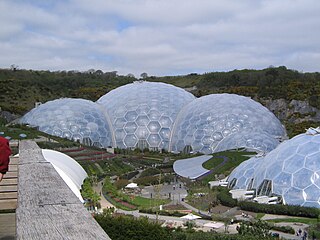 W
WThe Eden Project is a visitor attraction in Cornwall, England, UK. The project is located in a reclaimed china clay pit, located 2 km (1.2 mi) from the town of St Blazey and 5 km (3 mi) from the larger town of St Austell.
 W
WEGM Green LLC. is an American private corporation, specializing in Design and Manufacture of eco-friendly casino gaming products.
 W
WEnergetically modified cements (EMCs) are a class of cements made from pozzolans, silica sand, blast furnace slag, or Portland cement. The term "energetically modified" arises by virtue of the mechanochemistry process applied to the raw material, more accurately classified as "high energy ball milling" (HEBM). This causes, amongst others, a thermodynamic transformation in the material to increase its chemical reactivity. For EMCs, the HEBM process used is a unique form of specialised vibratory milling discovered in Sweden and applied only to cementitious materials, here called "EMC Activation".
 W
WENBau is an initiative of Swiss universities for training in sustainable building with the goal of resource efficiency of buildings in the areas of energy, water, materials and processes.
 W
WEnvironmental assessment (EA) is the assessment of the environmental consequences of a plan, policy, program, or actual projects prior to the decision to move forward with the proposed action. In this context, the term "environmental impact assessment" (EIA) is usually used when applied to actual projects by individuals or companies and the term "strategic environmental assessment" (SEA) applies to policies, plans and programmes most often proposed by organs of state. It is a tool of environmental management forming a part of project approval and decision-making. Environmental assessments may be governed by rules of administrative procedure regarding public participation and documentation of decision making, and may be subject to judicial review.
 W
WFeng shui, also known as Chinese geomancy, is a pseudoscientific traditional practice originating from ancient China, which claims to use energy forces to harmonize individuals with their surrounding environment. The term 'feng shui' literally translated as "wind-water" in English, is taken from a passage of the now-lost Book of Burial recorded in Guo Pu's commentary.
 W
WThe grade of a physical feature, landform or constructed line refers to the tangent of the angle of that surface to the horizontal. It is a special case of the slope, where zero indicates horizontality. A larger number indicates higher or steeper degree of "tilt". Often slope is calculated as a ratio of "rise" to "run", or as a fraction in which run is the horizontal distance and rise is the vertical distance.
 W
WFounded 2005 the Green Electronics Council (GEC) is a mission-driven non-profit that promotes green computing and works towards the adoption of environmentally friendly practices.
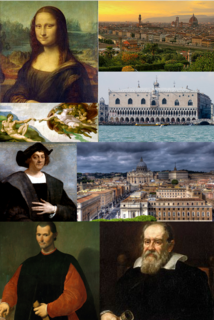 W
WThe Italian Renaissance was a period in Italian history that covered the 14th through the 17th centuries. The period is known for the development of a culture that spread across Europe and marked the transition from the Middle Ages to modernity. Proponents of a "long Renaissance" argue that it started around the year 1300 and lasted until about 1600. In some fields, a Proto-Renaissance, beginning around 1250, is typically accepted. The French word renaissance means 'rebirth', and defines the period as one of cultural revival and renewed interest in classical antiquity after the centuries during what Renaissance humanists labeled as the "Dark Ages". The Renaissance author Giorgio Vasari used the term rinascita 'rebirth' in his Lives of the Most Excellent Painters, Sculptors, and Architects in 1550, but the concept became widespread only in the 19th century, after the work of scholars such as Jules Michelet and Jacob Burckhardt.
 W
WLand art, variously known as Earth art, environmental art, and Earthworks, is an art movement that emerged in the 1960s and 1970s, largely associated with Great Britain and the United States but that also includes examples from many countries. As a trend, "land art" expanded boundaries of art by the materials used and the siting of the works. The materials used were often the materials of the Earth, including the soil, rocks, vegetation, and water found on-site, and the sites of the works were often distant from population centers. Though sometimes fairly inaccessible, photo documentation was commonly brought back to the urban art gallery.
 W
WLandscape design is an independent profession and a design and art tradition, practiced by landscape designers, combining nature and culture. In contemporary practice, landscape design bridges the space between landscape architecture and garden design.
 W
WLandscape ecology is the science of studying and improving relationships between ecological processes in the environment and particular ecosystems. This is done within a variety of landscape scales, development spatial patterns, and organizational levels of research and policy. Concisely, landscape ecology can be described as the science of landscape diversity as the synergetic result of biodiversity and geodiversity.
 W
WLeadership in Energy and Environmental Design (LEED) is a green building certification program used worldwide. Developed by the non-profit U.S. Green Building Council (USGBC), it includes a set of rating systems for the design, construction, operation, and maintenance of green buildings, homes, and neighborhoods, which aims to help building owners and operators be environmentally responsible and use resources efficiently. By 2015, there were over 80,000 LEED-certified buildings and over 100,000 LEED-accredited professionals. Most LEED-certified buildings are located in major U.S. metropolises. LEED Canada has developed a separate rating system for the regulations and climate of that country.
 W
WMaharishi Vastu Architecture (MVA) is a set of architectural and planning principles assembled by Maharishi Mahesh Yogi based on "ancient Sanskrit texts". Maharishi Vastu Architecture is also called "Maharishi Sthapatya Veda", "Fortune-Creating" buildings and homes, and "Maharishi Vedic architecture".
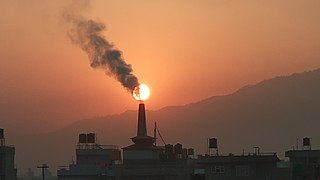 W
WNoise control or noise mitigation is a set of strategies to reduce noise pollution or to reduce the impact of that noise, whether outdoors or indoors.
 W
WA parkway is a landscaped thoroughfare. The term is particularly used for a roadway in a park or connecting to a park from which trucks and other heavy vehicles are excluded.
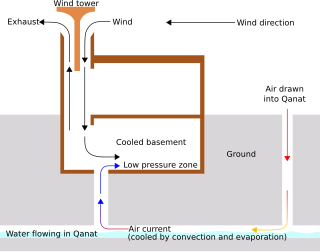 W
WPassive cooling is a building design approach that focuses on heat gain control and heat dissipation in a building in order to improve the indoor thermal comfort with low or no energy consumption. This approach works either by preventing heat from entering the interior or by removing heat from the building.
 W
WPermaculture is, amongst others, an approach to land management that adopts arrangements observed in flourishing natural ecosystems. It includes a set of design principles derived using whole systems thinking. It uses these principles in fields such as regenerative agriculture, rewilding, and community resilience. Permaculture originally came from "permanent agriculture", but was later adjusted to mean "permanent culture", incorporating social aspects as inspired by Masanobu Fukuoka's natural farming. The term was coined by Bill Mollison and David Holmgren in 1978, who formulated the concept in opposition to Western industrialized methods and in congruence with Indigenous or traditional knowledge.
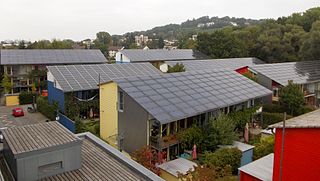 W
WAn energy-plus building produces more energy from renewable energy sources, over the course of a year, than it imports from external sources. This is achieved using a combination of microgeneration technology and low-energy building techniques, such as: passive solar building design, insulation and careful site selection and placement. A reduction of modern conveniences can also contribute to energy savings, however many energy-plus houses are almost indistinguishable from a traditional home, preferring instead to use highly energy-efficient appliances, fixtures, etc., throughout the house.
 W
WThe Power Tower is the first high-rise office tower to attempt to meet the strict Passive House energy efficiency building standard. It was built to house the corporate headquarters of the Austrian utility company Energie AG in Linz, Austria.
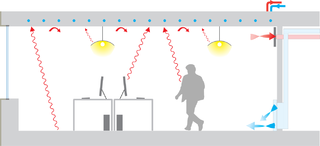 W
WRadiant heating and cooling is a category of HVAC technologies that exchange heat by both convection and radiation with the environments they are designed to heat or cool. There are many subcategories of radiant heating and cooling, including: "radiant ceiling panels", "embedded surface systems", "thermally active building systems", and infrared heaters. According to some definitions, a technology is only included in this category if radiation comprises more than 50% of its heat exchange with the environment; therefore technologies such as radiators and chilled beams are usually not considered radiant heating or cooling. Within this category, it is practical to distinguish between high temperature radiant heating, and radiant heating or cooling with more moderate source temperatures. This article mainly addresses radiant heating and cooling with moderate source temperatures, used to heat or cool indoor environments. Moderate temperature radiant heating and cooling is usually composed of relatively large surfaces that are internally heated or cooled using hydronic or electrical sources. For high temperature indoor or outdoor radiant heating, see: Infrared heater. For snow melt applications see: Snowmelt system.
 W
WRadiant heating and cooling is a category of HVAC technologies that exchange heat by both convection and radiation with the environments they are designed to heat or cool. There are many subcategories of radiant heating and cooling, including: "radiant ceiling panels", "embedded surface systems", "thermally active building systems", and infrared heaters. According to some definitions, a technology is only included in this category if radiation comprises more than 50% of its heat exchange with the environment; therefore technologies such as radiators and chilled beams are usually not considered radiant heating or cooling. Within this category, it is practical to distinguish between high temperature radiant heating, and radiant heating or cooling with more moderate source temperatures. This article mainly addresses radiant heating and cooling with moderate source temperatures, used to heat or cool indoor environments. Moderate temperature radiant heating and cooling is usually composed of relatively large surfaces that are internally heated or cooled using hydronic or electrical sources. For high temperature indoor or outdoor radiant heating, see: Infrared heater. For snow melt applications see: Snowmelt system.
 W
WRalph Appelbaum Associates (RAA) is one of the world's longest-established and largest museum exhibition design firms with offices in New York City, London, Beijing, Berlin, Moscow, and Dubai.
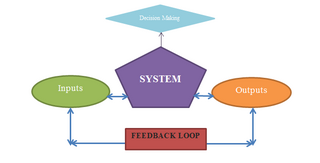 W
WRegenerative design is a process-oriented whole systems approach to design. The term "regenerative" describes processes that restore, renew or revitalize their own sources of energy and materials. Regenerative design uses whole systems thinking to create resilient and equitable systems that integrate the needs of society with the integrity of nature.
 W
WA reusable shopping bag is a type of shopping bag which can be reused many times, in contrast to single-use paper or plastic shopping bags. It is often a tote bag made from fabric such as canvas, natural fibres such as jute, woven synthetic fibers, or a thick plastic that is more durable than disposable plastic bags, allowing multiple use. Other shoppers may use a string bag or a wheeled trolley bag.
 W
WA road verge is a strip of grass or plants, and sometimes also trees, located between a roadway (carriageway) and a sidewalk (pavement). Verges are known by dozens of other names, often quite regional; see Terminology, below.
 W
WThe rural–urban fringe, also known as the outskirts, rurban, peri-urban or the urban hinterland, can be described as the "landscape interface between town and country", or also as the transition zone where urban and rural uses mix and often clash. Alternatively, it can be viewed as a landscape type in its own right, one forged from an interaction of urban and rural land uses.
 W
WSITE is an architecture and environmental design firm founded in 1970 by James Wines.
 W
WSociology of architecture is the sociological study of the built environment and the role and occupation of architects in modern societies.
 W
WA spatial network is a graph in which the vertices or edges are spatial elements associated with geometric objects, i.e., the nodes are located in a space equipped with a certain metric. The simplest mathematical realization of spatial network is a lattice or a random geometric graph, where nodes are distributed uniformly at random over a two-dimensional plane; a pair of nodes are connected if the Euclidean distance is smaller than a given neighborhood radius. Transportation and mobility networks, Internet, mobile phone networks, power grids, social and contact networks and biological neural networks are all examples where the underlying space is relevant and where the graph's topology alone does not contain all the information. Characterizing and understanding the structure, resilience and the evolution of spatial networks is crucial for many different fields ranging from urbanism to epidemiology.
 W
WSuperinsulation is an approach to building design, construction, and retrofitting that dramatically reduces heat loss by using much higher levels of insulation and airtightness than normal. Superinsulation is one of the ancestors of the passive house approach.
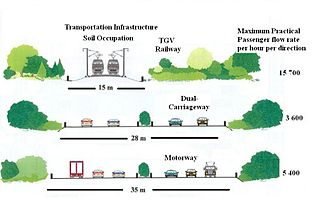 W
WSustainable urban infrastructure expands on the concept of urban infrastructure by adding the sustainability element with the expectation of improved and more resilient urban development. In the construction and physical and organizational structures that enable cities to function, sustainability also aims to meet the needs of the present generation without compromising the capabilities of the future generations.
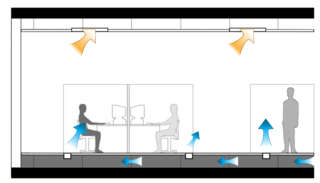 W
WUnderfloor air distribution (UFAD) is an air distribution strategy for providing ventilation and space conditioning in buildings as part of the design of a HVAC system. UFAD systems use an underfloor supply plenum located between the structural concrete slab and a raised floor system to supply conditioned air through floor diffusers directly into the occupied zone of the building. UFAD systems are similar to conventional overhead systems (OH) in terms of the types of equipment used at the cooling and heating plants and primary air-handling units (AHU). Key differences include the use of an underfloor air supply plenum, warmer supply air temperatures, localized air distribution and thermal stratification. Thermal stratification is one of the featured characteristics of UFAD systems, which allows higher thermostat setpoints compared to the traditional overhead systems (OH). UFAD cooling load profile is different from a traditional OH system due to the impact of raised floor, particularly UFAD may have a higher peak cooling load than that of OH systems. This is because heat is gained from building penetrations and gaps within the structure itself. UFAD has several potential advantages over traditional overhead systems, including layout flexibility, improved thermal comfort and ventilation efficiency, reduced energy use in suitable climates and life-cycle costs. UFAD is often used in office buildings, particularly highly-reconfigurable and open plan offices where raised floors are desirable for cable management. UFAD is appropriate for a number of different building types including commercials, schools, churches, airports, museums, libraries etc. Notable buildings using UFAD system in North America include The New York Times Building, Bank of America Tower and San Francisco Federal Building. Careful considerations need to be made in the construction phase of UFAD systems to ensure a well-sealed plenum to avoid air leakage in UFAD supply plenums.
 W
WUrban sprawl is the unrestricted growth in many urban areas of housing, commercial development, and roads over large expanses of land, with little concern for urban planning. In addition to describing a special form of urbanization, the term also relates to the social and environmental consequences associated with this development. Since the advent of the industrial era, sprawl has entailed no direct disadvantages, such as the loss of protection from medieval city walls. However, its disadvantages and costs include increased travel time, transport costs, pollution, and destruction of countryside. The cost of building the infrastructure needed for new developments is hardly ever recouped through property taxes, amounting to a huge subsidy for the developers and new residents at the expense of existing property taxpayers. In Continental Europe, the term peri-urbanisation is often used to denote similar dynamics and phenomena, but the term urban sprawl is currently being used by the European Environment Agency. There is widespread disagreement about what constitutes sprawl and how to quantify it. For example, some commentators measure sprawl only with the average number of residential units per acre in a given area, but others associate it with decentralization, discontinuity, segregation of uses, and so forth.
 W
WVastu shastra are texts on the traditional Indian system of architecture. These texts describe principles of design, layout, measurements, ground preparation, space arrangement, and spatial geometry. The designs aim to integrate architecture with nature, the relative functions of various parts of the structure, and ancient beliefs utilising geometric patterns (yantra), symmetry, and directional alignments.
 W
WA Zero Energy Building (ZEB), also known as a Net Zero Energy (NZE) building, or a Zero Net Energy (ZNE) building, is a building with net zero energy consumption, meaning the total amount of energy used by the building on an annual basis is equal to the amount of renewable energy created on the site or in other definitions by renewable energy sources offsite, using technology such as heat pumps, high efficiency windows and insulation, and solar panels. The goal is that these buildings contribute less overall greenhouse gas to the atmosphere during operations than similar non-ZNE buildings. They do at times consume non-renewable energy and produce greenhouse gases, but at other times reduce energy consumption and greenhouse gas production elsewhere by the same amount. Zero-energy buildings are not only driven by a want to have less of an impact on the environment, but they are also driven by money. Tax breaks as well as savings on energy costs make Zero-energy buildings financially viable. A similar concept approved and implemented by the European Union and other agreeing countries is nearly Zero Energy Building (nZEB), with the goal of having all buildings in the region under nZEB standards by 2020. Terminology tends to vary between countries, agencies, cities, towns and reports, so a general knowledge of this concept and its various employments is essential for a versatile understanding of clean energy and renewables. The IEA and European Union most commonly use Net Zero Energy, with "zero net" mainly used in the USA.